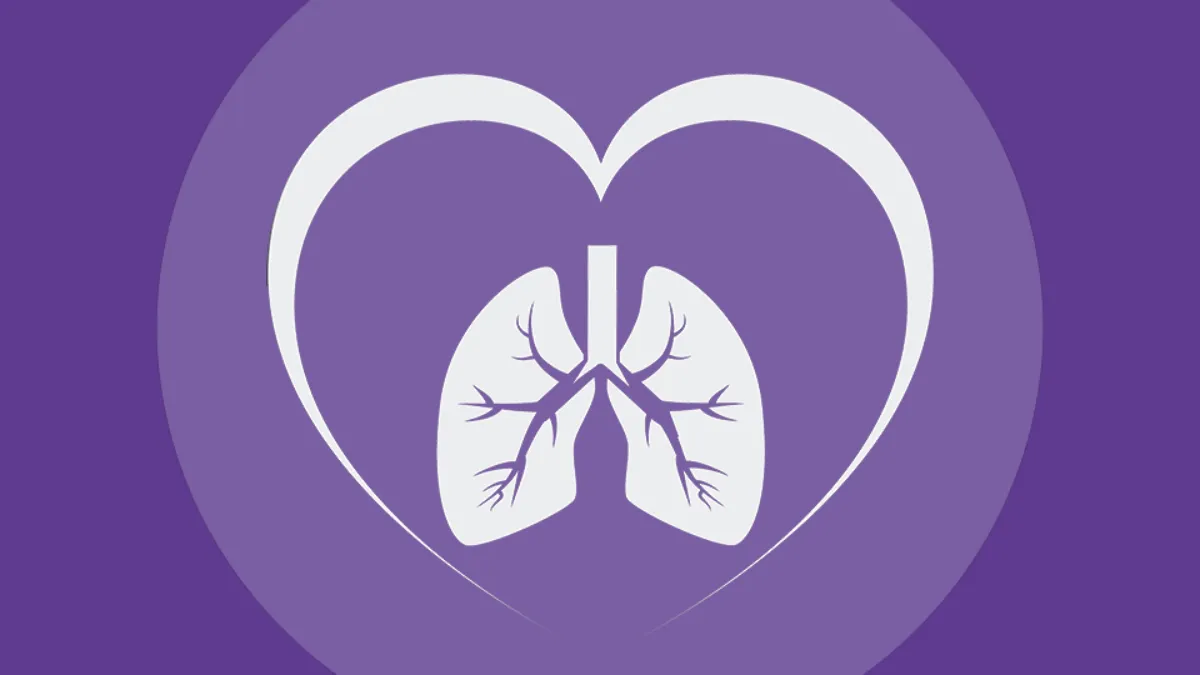The link between impaired spirometry and increased likelihood of cardiovascular disease

Introduction #
Cardiovascular disease (CVD) and Chronic Obstructive Pulmonary Disease (COPD) are the first and third leading causes of death in the United States1,but these two diseases have more in common than just their ranking. While CVD is often thought to be focused solely on the heart and COPD on the lungs, they are more closely linked than many realize.
COPD and CVD often appear together as comorbid conditions.2 In those with COPD, commonly occurring cardiovascular diseases include ischaemic heart disease (IHD), heart failure, and cardiac arrhythmias.2 This CVD comorbidity exists irrespective of the severity of airflow obstruction, so patients with less severe COPD can still encounter it.2 However, it is not yet definitively known if cardiovascular diseases are more common within specific subtypes of COPD patients.2 A reverse association also exists among those with cardiovascular diseases.2 For example, as much as one-third of those with IHD experience COPD.2
Although comorbidity of these two diseases is common, it is serious and contributes to high healthcare costs.2 Those with COPD who have a CVD comorbidity are at greater risk for hospitalization and even death.2They also experience longer hospitalization stays and more 30-day re-admissions.2
The connection between pulmonary and cardiovascular health #
Let’s take a deeper look at how pulmonary and cardiovascular health are connected.
While it is true that CVD and COPD share many of the same risk factors including cigarette smoking, aging, and a sedentary lifestyle, it appears there may also be pathophysiological links between the two diseases which include: lung hyperinflation, hypoxaemia, pulmonary hypertension, systemic inflammation and oxidative stress, exacerbations, shared risk factors and genetics, and COPD phenotype.3
One hypothesis linking COPD and CVD notes that chronic inflammation from COPD aids in atherosclerotic plaque formation and, in certain situations, can lead to a cardiovascular event.2 However, an ECLIPSE study found that this type of systematic inflammation is not present in all COPD patients.2 Mechanisms related to arterial stiffness, especially for the elderly and patients with advanced emphysematous disease, may account for a greater connection between COPD and CVD.2
Another mechanistic link is accelerated aging processes, which includes, but is not limited to, telomere shortening and cellular senescence, which has been found in COPD patients.2 Telomere shortening leads to further arterial stiffness, and cellular senescence may contribute to endothelial dysfunction and atherogenesis.2
While researchers are still working to explain these complex mechanistic pathways, it is clear that COPD is more than solely a disease of the lungs.2
Despite these connections between COPD and cardiovascular health, there is underdiagnosis and undertreatment of these comorbid diseases due to a variety of factors including a lack of detailed clinical guidelines.2 To remedy this gap, some suggest diagnostic procedures and tests, such as spirometry, during routine check-ups for CVD and COPD patients.2
Spirometry and cardiovascular health #
Spirometry is often associated with diagnosing and monitoring lung disease, but it also plays an important role in determining cardiovascular risk.4
Shared risk factors between cardiovascular disease and COPD including smoking and a sedentary lifestyle means that those at risk for cardiovascular disease could benefit from spirometry since they are also at risk for COPD.Moreover, spirometry is not only effective but also simple and inexpensive.4
However, despite the coexistence of these diseases, spirometry is not often utilized among heart disease patients. In fact, cardiologists who examined patients for dyspnea, utilized4 spirometry testing less than 30 percent of the time.4
Also, in a study of 205 patients screened for coronary artery disease, 28 percent were determined to have abnormal lung function when tested with spirometry.These results indicate that respiratory disease and abnormal lung function are underdiagnosed in patients who undergo cardiac screenings.4
The link between impaired spirometry and increased CVD risk #
Jean Bourbeau, MD, MSc, FRCPC, FCAHS, professor and senior scientist at McGill University, and his colleagues found in the Canadian Cohort Obstructive Lung Disease (CanCOLD) study that, among 1,561 individuals followed over 6.3 years, those with impaired spirometry and COPD had increased odds for cardiovascular disease.5 Their risk was also higher for incident cardiovascular disease.5
Bourbeau considers COPD a cardiopulmonary disease and recommends integrated care for improved outcomes for patients with COPD and CVD.5 To further drive home the importance of COPD management and early detection he notes, “Current Global Initiative for Chronic Obstructive Lung Disease (GOLD) reports recommend assessing all patients with COPD for cardiovascular disease.”5
Additionally, spirometry is supported by the Atherosclerosis Risk in Communities (ARIC) study, a massive epidemiological effort that found a rapid decline in forced expiratory volume in 1 second (FEV1) as associated with a quadrupled risk of heart failure in the following year, independent of race or sex.1
Conclusion - Importance of early detection #
It is often assumed that spirometry is specific to the lungs; however, spirometry can actually play a critical role in assessing the risk of cardiovascular disease. Early intervention and diagnosis can help guide better treatment plans and help with disease management and may also help to prevent disease progression.
Incorporating spirometry into the initial diagnostic process and subsequent follow-ups should be considered with patients with cardiovascular disease.
Silvestre OM, Nadruz W, Querejeta Roca G, Claggett B, Solomon SD, Mirabelli MC, et al. Declining Lung Function and Cardiovascular Risk. Journal of the American College of Cardiology. 2018 Sep;72(10):1109–22. Available from: https://www.ncbi.nlm.nih.gov/pmc/articles/PMC6121739/ ↩︎ ↩︎
Morgan AD, Zakeri R, Quint JK. Defining the relationship between COPD and CVD: what are the implications for clinical practice? Therapeutic Advances in Respiratory Disease [Internet]. 2018 Jan 22;12:175346581775052. Available from: https://www.ncbi.nlm.nih.gov/pmc/articles/PMC5937157/ ↩︎ ↩︎ ↩︎ ↩︎ ↩︎ ↩︎ ↩︎ ↩︎ ↩︎ ↩︎ ↩︎ ↩︎ ↩︎ ↩︎ ↩︎ ↩︎ ↩︎
Rabe KF, Hurst JR, Suissa S. Cardiovascular disease and COPD: dangerous liaisons? European Respiratory Review [Internet]. 2018 Sep 30;27(149):180057. Available from: https://err.ersjournals.com/content/27/149/180057 ↩︎
Fernandes FLA, Carvalho-Pinto RM, Stelmach R, Salge JM, Rochitte CE, Souza EC dos S, et al. Spirometry in patients screened for coronary artery disease: is it useful? Jornal Brasileiro de Pneumologia [Internet]. 2018 Aug 1 [cited 2021 Mar 28];44(4):299–306. Available from: https://www.scielo.br/scielo.php?script=sci_arttext&pid=S1806-37132018000400299 ↩︎ ↩︎ ↩︎ ↩︎ ↩︎
Impaired spirometry, COPD raise cardiovascular disease prevalence, incidence [Internet]. www.healio.com. [cited 2024 Mar 5]. Available from: https://www.healio.com/news/pulmonology/20240219/impaired-spirometry-copd-raise-cardiovascular-disease-prevalence-incidence ↩︎ ↩︎ ↩︎ ↩︎
Written by

Kelly Sicard
MA
Kelly M. Sicard is a freelance writer with an M.A. in English & Creative Writing who spent over a decade working for a non-profit lung health organization. She lives in New Hampshire with her husband, daughter, and black labrador and enjoys reading, writing, listening to stories, appreciating nature, and spending time with family.










